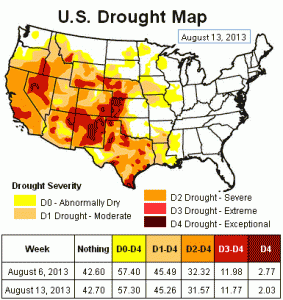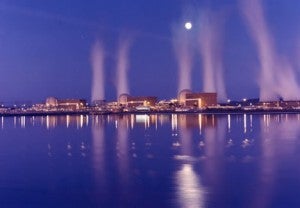Over the past few weeks, I’ve written a number of posts to help shed light on the fundamental connection between energy and water. Because many of our energy sources gulp down huge volumes of water, it’s imperative that we break down the long-standing division between energy and water planning — especially in drought-prone states like Texas. I’d like to take a step back and look at how Texas’ neighbors are addressing energy and water co-management. While Texas may be an extreme example, looking toward its immediate neighbors could provide ideas and best practices to improve the state’s situation.
A number of western states are facing many of the same challenges as Texas. Electricity production is a major drain on the region’s water supply. A study co-authored by Western Resource Advocates and EDF showed that thermoelectric power plants, such as coal, natural gas and nuclear, in Arizona, Colorado, New Mexico, Nevada and Utah consumed an estimated 292 million gallons of water each day in 2005 — roughly equal to the amount of water consumed by Denver, Phoenix and Albuquerque combined (and we’re talking water consumption, not just withdrawals). Like Texas, the western states face a future of prolonged drought. Scientific models predict climate change will increase drought throughout the Southwest, placing greater stress on the region’s delicate water supply.
Additionally, electricity production, numerous thirsty cities and widespread agricultural activity all strain the water system, too. Because so many flock to western states for fishing, kayaking, rafting and other recreational water activities, setting the region’s water system on a sustainable path is a critical economic issue. The exceptional challenges facing western states have already prompted some states to consider the energy-water nexus when planning to meet future water and electricity needs.
Arizona
Arizona is at the forefront of innovative co-management policies that address the energy-water nexus. The Arizona Corporation Commission (ACC), the state agency charged with regulating electricity, has considered water in its electric resource planning for over ten years — and as we have acknowledged before – water use is no small consideration. The agency has gone so far as to deny permits for proposed natural gas power plants partially due to their impact on groundwater supplies. The ACC has also ordered Arizona Public Service (APS), the state’s largest and longest-serving electric company, to consider building new solar farms, specifically noting solar energy’s low-water needs. To APS’ credit, the company has reported water consumption for its energy portfolio since 2009, although water has been a factor in energy planning for far longer than that. Since the 1980s, the Palo Verde nuclear plant has used treated wastewater from the city of Phoenix rather than fresh water, successfully offsetting 20 billion gallons of fresh water consumption each year.
One of Arizona’s largest utilities, the Salt River Project (SRP), provides both water and electricity services to the Phoenix metropolitan area. Oddly enough, SRP considers water in its electric planning, but does not consider electricity in its water planning. In its electric planning, SRP estimates the monetary and social costs of new water supplies needed for power plants, but doesn’t consider the explicit economic value of the water resource itself. Thus, despite SRP’s admirable work on the energy-water nexus, it’s not looking at the full picture.
While the electric side of the equation is making strides to bridge energy and water planning, the water side is farther behind. An illustrative example is the Central Arizona Project, a 336-mile aqueduct that delivers 500 billion gallons of water per year to Tucson and Phoenix. In addition to being the largest and most expensive aqueduct system ever constructed in the United States, it is also the leading electricity user in Arizona. Each year, the aqueduct uses 2.8 million megawatt-hours of energy (about a quarter of the energy produced by a coal-fired power plant) to move water across the desert and up mountains.
Some areas of Arizona are working to reduce water’s enormous energy footprint. For instance, the City of Tucson has a robust water recycling program. By using recycled water rather than drinking water for irrigation, the city saves enough water to provide for over 60,000 families each year, reducing the city’s reliance on more energy-intensive freshwater supplies.
Colorado
Colorado is another state working to unite energy and water planning. The state’s renewable portfolio standard, passed by voters in 2004, highlights renewable energy’s smaller water footprint. The state also encourages the Colorado Public Utilities Commission (PUC) to consider water resources in its electric planning and to include water usage when evaluating permits for new power plants. For the past three years, the state has required utilities to report water withdrawal and consumption information for all of their power plants.
Notably, it seems Colorado policymakers have realized the energy-water nexus is a two-way street. In addition to the state’s electric sector considering water use, the state’s water planners intend to include a segment on the energy-water nexus in their upcoming state water plan. Some Colorado cities have even stepped up to address the challenge.
Fort Collins quantified its greenhouse gas (GHG) emissions as part of its Climate Action Plan and, in the process, discovered that 26% of the city’s GHGs came from its water and wastewater facilities. Within two years, city officials were able to reduce electricity use for water and wastewater by over 7%. Having a comprehensive climate action plan that acknowledges the connection between energy and water enabled city planners to identify novel energy savings and tackle the energy-water interconnection head on.
While all of the western states are threatened by the effects of climate change and the energy-water nexus, some states are doing more to prepare than others. Western states should look to regional leaders, like Colorado and Arizona, as they develop policies to address this imminent challenge. Texas can learn from what other states in the West are doing. Our water and electricity planners should be looking at each other’s sectors as a matter of course and adopting innovative solutions that reduce energy’s water needs and water’s energy needs for a sustainable future—solutions I plan to investigate in my next post.
This is one of a group of posts that examines the energy-water nexus, Texas’ current approach to energy and water policy and what Texans can learn from other places to better manage its vital resources.












One Comment
Thanks for throwing light on Texas’ current approach to energy and water policy. It is essential for Texas to learn from other states on how to make efficient use of a precious resource like water.